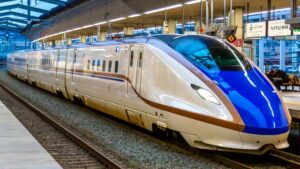 JR East is advancing the introduction of autonomous driving technology (driverless operation) in line with its Group Management Vision "Transformation 2027," aiming for efficient and sustainable railway operations. This initiative is designed to respond to societal changes such as population decline and work style reforms, and to lead the future of the railway industry.
JR East is advancing the introduction of autonomous driving technology (driverless operation) in line with its Group Management Vision "Transformation 2027," aiming for efficient and sustainable railway operations. This initiative is designed to respond to societal changes such as population decline and work style reforms, and to lead the future of the railway industry.
Benefits of Autonomous Driving
- Enhanced Safety and Operational Stability: Autonomous driving reduces human errors and lowers the risk of accidents. It also maintains a consistent operating schedule, improving train operation stability.
- Energy Efficiency: Efficient driving reduces energy consumption and allows for flexible train operations based on demand.
- Flexible Workforce Utilization: With train operators able to engage in other tasks, overall efficiency in railway operations improves.
Plans for Autonomous Driving in Shinkansen
- Joetsu Shinkansen:
- 2028: Introduction of autonomous driving (GOA2) for passenger and freight trains between Nagaoka Station and Niigata Shinkansen Vehicle Center (60.8 km).
- 2029: Introduction of driverless operation (GOA4) for freight trains between Niigata Station and Niigata Shinkansen Vehicle Center (5.1 km).
- Future Prospects:
- Mid-2030s: Consideration of GOA2 for the Tokyo Station to Nagaoka Station segment and GOA3 and GOA4 for the Tokyo Station to Niigata Station segment.
- Expansion of autonomous driving to Hokuriku and Tohoku Shinkansen lines.
Overview of GOA (Levels of Autonomous Driving)
- GOA2: Driver present but basic operation is autonomous.
- GOA3: Driver present but not required to be at the front of the train (driverless operation).
- GOA4: Fully autonomous operation with no crew on board.
Research and Development Progress
- Optimal Driving Pattern Device Development: Development of a device that automatically adheres to schedules while accommodating temporary speed restrictions and stops. Testing began in 2019 with the E956 series Shinkansen (ALFA-X).
- Abnormal Vibration Detection Device: Development of a system to detect abnormal vibrations in the bogies and automatically trigger emergency stops. This feature aims to be implemented by the 2029 GOA4 introduction.
Through these efforts, JR East demonstrates its commitment to achieving safer and more efficient railway operations and leading the global railway industry.